Exercises (75)
Power: Types of impact
Light-Contact
Partner work


Two participants stand one behind the other in front of the raised (large) soft mat. For 10-15 seconds, the person in front boxes a predetermined punch or punch combination against the mat (really exhausting themselves). Once the time has elapsed, he makes room for his partner and lines up behind him. The second participant now begins to hit the mat. The sports director specifies the number of passes.
Participant:
1 pair of boxing gloves
Pro group:
1 soft mat (large)
Strength: Skipping rope
Light-Contact
Individual work
Skipping rope:
- bipedal
- jumping on one leg (left/right)
- right/left leg first (variation: lift leg/knee correctly or jump only lightly on the ball of the foot)
- alternating right/left leg first (variation: lift leg/knee correctly or jump only lightly on the ball of the foot)
- alternating left/right heel on the floor
1 skipping rope
Strength/duel: abduction and adduction of the legs in push-up position and push-up
Light-Contact
Partner work
In the push-up position, support your arms with your hands on an inverted long bench and place your legs on the floor. Spread your legs apart in small jumps and bring them back together in the starting position. However, a push-up (bending and stretching the arms) is also integrated into the exercise in the position with the legs apart before the legs are brought together.
Variant:
Vary the position of the hands/arms (e.g. wide, narrow, together).
Duelling:
After the strengthening exercise, a light contact fight takes place on the wide or narrow side of the inverted long bench.
Per group of 2:
1 long bench
Participant:
1 pair of boxing gloves
Strength/duel: alternating raising and lowering of one leg in forearm support
Light-Contact
Partner work
In the forearm support, the outstretched legs and upper body practically form a line. The legs are supported by the tips of the toes on an inverted long bench and the upper body is supported by the forearms on the floor. The forearms lie flat and parallel to each other with the upper arms resting vertically on the floor (90 degree angle at the elbow joint). Alternately, one leg is raised slightly (foot approximately at heel height).
Duelling:
After the strengthening exercise, a light contact fight takes place on the wide or narrow side of the inverted long bench.
Per group of 2:
1 long bench
Participant:
1 pair of boxing gloves
Strength/duel: Push-up
Light-Contact
Partner work
Push-up position, legs placed on the inverted long bench; bend and stretch arms (lower and raise upper body).
Variant:
Vary the position of the hands/arms (e.g.: wide, narrow, together).
Duelling:
After the strengthening exercise, a light contact fight takes place on the wide or narrow side of the inverted long bench.
Per group of 2:
1 long bench
Participant:
1 pair of boxing gloves
Strength/duel: push-up and jump over an object
Light-Contact
Partner work
From a standing position, bend your legs and place your hands next to your feet to get into a squat position. Support yourself with your hands and jump backwards with both legs to get into a push-up position. Bend your arms to fully lower your upper body (prone position). From the prone position, push back into the push-up position with both arms and jump back into the squat position. In the squat position, the upper body is slightly tilted forwards, stretch your arms backwards at an angle along your body (like a ski jumper on a ski jump), push off the floor powerfully to perform a jump (lateral-sided) over the long bench (use the momentum of the arms). Straighten the upper body and restart the exercise (assume a push-up position) to finally jump back to the starting position.
Variant:
Jump frontally over the long bench.
Duelling:
After the strengthening exercise, a light contact fight takes place on the wide or narrow side of the inverted long bench.
Per group of 2:
1 long bench
Participant:
1 pair of boxing gloves
Strength/duel: Jumping over an object from the side with the upper body supported
Light-Contact
Partner work
Support your upper body with your arms on the inverted long bench. Jump with both legs from one side of the long bench to the other.
Variant:
Land and jump with the outer leg only.
Duelling:
After the strengthening exercise, a light contact fight takes place on the wide or narrow side of the inverted long bench.
Per group of 2:
1 long bench
Participant:
1 pair of boxing gloves
Strength/duel: alternating jump on an object
Light-Contact
Partner work
Stand with one leg on the inverted long bench and the other leg on the floor. Alternate the foot position while jumping.
Duelling:
After the strengthening exercise, a light contact fight takes place on the wide or narrow side of the inverted long bench.
Per group of 2:
1 long bench
Participant:
1 pair of boxing gloves
Avoidance artist
Light-Contact
Partner work
Regular change of roles and partners
.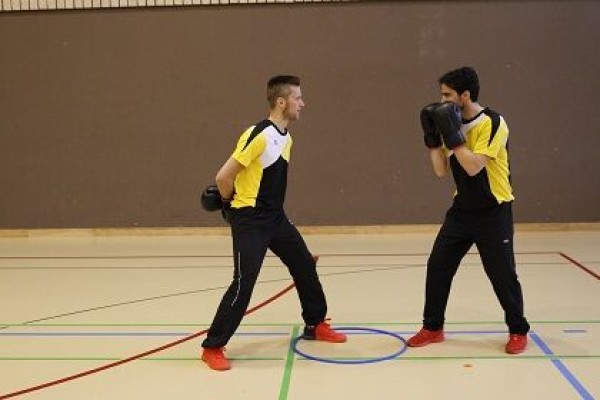

Participant A stands in a stepping position with their arms crossed behind their back and their front foot in a tyre. Participant B stands in box position and is allowed to move freely. Participant B now tries to hit A on the forehead with single straights (no series, combinations or feints). A tries to prevent these hits by avoiding them. Each hit scores one point. If B hits too hard, all points are lost. Roles change after a set time or after reaching a certain number of points.
Variations:
- Feint allowed;
- Do not perform as a competition form. B deliberately hits slower so that A can practise avoidance;
- Avoidance to the back not allowed, only to the side and downwards;
- Cover/block allowed.
Participant:
1 pair of boxing gloves
Participant:
1 tyre
Shadow boxing
Light-Contact
Individual work


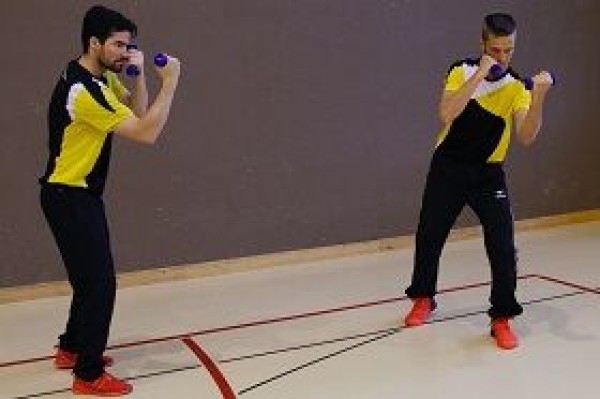
Stand dynamically on the balls of the feet. The participants hold weights (approx. 1 kg) in both hands, move freely around the room (look at all four walls/corners once) and perform the learnt punches (straight, sideways, uppercuts) against imaginary opponents. The fists are in the starting position in front of the face. The arms are never fully extended (maintain tension in the muscles and keep the elbow joint slightly bent). The fists are pulled back horizontally. Throughout the entire exercise unit, quality is more important than quantity (technically clean punches)!
Variant:
Only punch straight lines/sideways hooks/upward hooks.
Per participant:
2 dumbbells/filled pet bottles
Shadow run
Light-Contact
Partner work
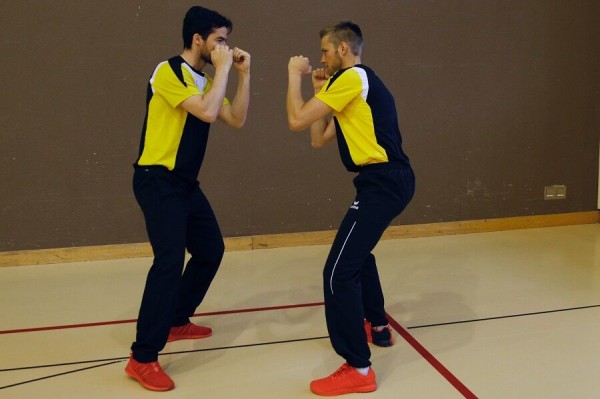
One participant moves into a boxing stance with a follow-through step. The feet remain shoulder-width apart, the foot that is closer to the direction of movement initiates the movement. The weight is on the balls of the feet, the steps are springy and gliding. The partner opposite always tries to keep the same distance and performs the same movements in mirror image (shadow walk).
Variant:
Touch the knuckle of your partner's little finger at eye level with every step.
No material required
Shadow run with touch
Light-Contact
Partner work
Regular change of roles and partners
.
One participant moves into a boxing stance with a follow-through step and sets the pace and direction. The feet remain shoulder-width apart, with the foot closest to the direction of movement initiating the movement. The weight is on the balls of the feet, the steps are springy and gliding. The partner opposite always tries to keep the same distance and performs the same movements in mirror image (shadow walk). As soon as the leading participant stands still, the other participant tries to touch the partner's shoulders twice crosswise with the respective palm (leading hand/punching hand).
Key points: move slowly to acquire the technique, maintain the same distance, keep your guard up, punch from the hip (metaphor: putting out a cigarette with your foot), reduce the distance when attacking (into the opponent) and then immediately move back again (detach yourself from the opponent).
Variant:
Acquisition of punch combinations by the instructor demonstrating different sequences:
1. lead hand
2. lead hand + punching hand
3. lead hand + punching hand + sideways hook (left)
4. lead hand + punching hand + sideways hook (left) + uppercut (right)
No material required
Type of stroke: Uppercut
Light-Contact
Individual work

Stance offset frontally to the soft mat placed on a bar. With both arms, alternate strikes from bottom to top (uppercuts) to the mat (underside of the opponent's chin). The elbows remain in front of the body and the opposite hand on the face for protection/defence. The legs and upper body are straightened simultaneously for the punch (use the power from the legs).
Uppercut:
The uppercut is the most difficult punch in terms of structure. It is triggered by hip rotation. In preparation, the fist and upper body are dropped slightly. The forearm is then brought up vertically in front of the body and the legs, hips and torso are stretched at the same time. The fist should hit the chin from below.
1 pair of boxing gloves
1 soft mat
1 parallel bars
Type of stroke: Uppercut
Light-Contact
Partner work
Uppercut:
The uppercut is the most difficult punch in terms of structure. It is triggered by hip rotation. In preparation, the fist and upper body are dropped slightly. The forearm is then brought up vertically in front of the body and the legs, hips and torso are stretched at the same time. The fist should hit the chin from below.
Exercise:
From the starting position, the partner stretches one hand slightly towards the other participant and raises the elbow so that the palm is pointing down towards the floor (open fist). The upper and lower arm are approximately at right angles. The attacker strikes an uppercut crosswise into the palm of the partner's hand. After a few punches, the roles are reversed. Caution: the attacker makes sure that the palm of the hand is facing their own body during the uppercut and that the upper body is dropped slightly before the punch.
Participant:
1 pair of boxing gloves
Type of stroke: Straight
Light-Contact
Individual work


Staggered stance frontally to the raised (large) soft mat. Alternate straight punches with both arms on the soft mat (against the opponent's chin, nose or forehead). The strike is straight and horizontal, the opposite hand remains on the face for protection/defence.
Straight punch:
The straight punch is delivered from the starting position in the most direct way to the target. This is done with an extension of the arm, at the same time as the hip rotates and the ball of the foot presses down on the same side. The elbow points towards the floor for as long as possible. As the punching fist is brought forward, the second fist goes back to the cheek (cover). The upper body and knees bend at the same time as the punch. The fist is at head height of the punching boxer. The head is thus protected by the shoulder. The boxing stance should then be resumed in a flash.
1 pair of boxing gloves
1 soft mat (large)
Type of stroke: Straight
Light-Contact
Partner work
Straight:
The straights are brought from the starting position to the target in the most direct way. This is done by stretching the arm while rotating the hips and pushing off the balls of the feet on the same side. The elbow points towards the floor for as long as possible. As the punching fist is brought forward, the second fist goes back to the cheek (cover). The upper body and knees bend at the same time as the punch. The fist is at head height of the punching boxer. The head is thus protected by the shoulder. Afterwards, the boxing stance should be assumed again in a flash.
Exercise:
The partner stretches one arm slightly towards the other participant from the starting position and turns the arm so that the palm is facing the other person (open fist). The attacker strikes a straight cross into the palm of the partner's hand, whereby the lead hand is referred to as a "jab". After a few punches, the roles are swapped. Watch out for possible mistakes: Head turned away, rear leg lifted off the ground or back position during the punching movement.
Participant:
1 pair of boxing gloves
Type of stroke: Straight (hard strokes)
Light-Contact
Partner work
Stance offset frontally to the punching bag. Strike the punching bag as hard as possible (1st pass: lead hand, 2nd pass: punching hand). The punch is straight and horizontal, the opposite hand remains on the face for protection/defence.
Straight line:
The straight lines are delivered from the starting position in the most direct way to the target. This is done by stretching the arm while rotating the hips and pushing off the ball of the foot on the same side. The elbow points towards the ground for as long as possible. When the punching fist is brought forward, the second fist goes back to the cheek (cover). The upper body and knees bend at the same time as the punch. The fist is at head height of the punching boxer. The head is thus protected by the shoulder. The boxing stance should then be resumed in a flash.
2 punching bags (one punching bag per participant)
Participant:
1 pair of boxing gloves
Type of stroke: Straight (fast strokes)
Light-Contact
Partner work
Both participants stand facing the raised (large) soft mat. Strike the soft mat with the highest possible cadence (1st pass: lead hand, 2nd pass: punching hand). The punch is straight and horizontal, the opposite hand remains on the face for protection/defence.
1 soft mat (large)
Participant:
1 pair of boxing gloves
Type of stroke: Sideways hook
Light-Contact
Individual work

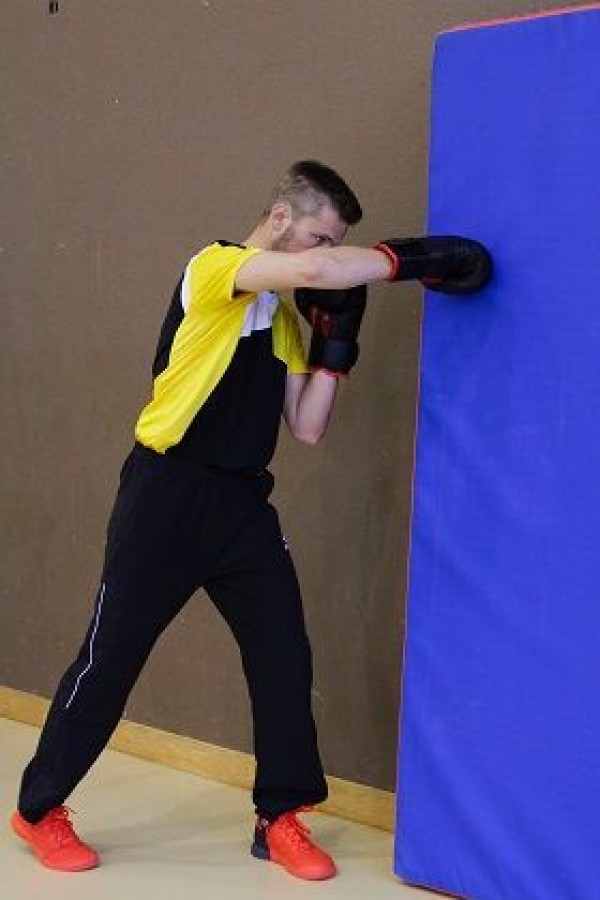
Stance offset frontally to the raised (large) soft mat (position of the boxer at the end of the soft mat). Strike the edge of the soft mat with the arm facing away from the mat (against the opponent's head). During the punch (semi-circular movement), the elbow remains at shoulder height and the back of the hand points upwards, with the opposite hand remaining on the face for protection/defence.
Sideways hook:
The sideways hook is triggered by pressing down on the ball of the foot and simultaneously pushing the hips forwards. The body rotates around the longitudinal axis. The arm is not stretched, but tilted 90 degrees during the rotation so that the fist, elbow and shoulder are at the same height. The fist should hit the side of the opponent's head. The chin is covered by the shoulder. The elbow and shoulder joints are at a 90 degree angle. The second hand lies at the side of the cheekbone, the forearm vertically in front of the torso.
1 pair of boxing gloves
1 soft mat (large)
Type of stroke: Sideways hook
Light-Contact
Partner work
Sideways hook:
The sideways hook is triggered by pressing down on the ball of the foot and pushing the hips forwards at the same time. The body rotates around the longitudinal axis. The arm is not stretched, but tilted 90 degrees during the rotation so that the fist, elbow and shoulder are at the same height. The fist should hit the side of the opponent's head. The chin is covered by the shoulder. The elbow and shoulder joints are at a 90 degree angle. The second hand lies at the side of the cheekbone, the forearm vertically in front of the torso.
Exercise:
The partner stretches one arm slightly towards the other participant from the starting position and opens the fist so that the back of the hand points to the respective side (e.g.: left hand is moved forwards, so the palm points to the right side). The attacker strikes a sideways cross into the palm of the partner's hand. After a few punches, the roles are reversed. Caution: the distance to the opponent is slightly closer with the sideways hook than with the straight punch. Also make sure that the elbow is held high at shoulder height (forearm and upper arm at a 90 degree angle).
Participant:
1 pair of boxing gloves
Impact types
Light-Contact
Individual work
Present - imitate
The participants practise independently, the instructor corrects
Introduction:
All punches are executed in such a way that the permitted target area is hit with the knuckle area. The punching boxer should remain as well covered as possible and at the same time have an efficient transfer of power. To do this, the weight is shifted to the second leg and the torso, hips and heel are rotated outwards until the shoulder protects the chin. The impact is made on the ball of the foot, with most of the power coming from the core muscles. As soon as the fist approaches the target, it is closed and the wrist is firmly tensed. Straight punches are struck from a long distance, hooks in close combat, i.e. when the opponents are body to body. Any punch can be thrown to the head or body.
The instructor demonstrates the different types of punch and the participants then practise them independently (shadow boxing). The instructor checks and corrects the exercises.
Strikes:
Target = nose, chin or forehead of the opponent.
The strikes are delivered from the starting position in the most direct way to the target (movement as straight as possible). This is done by stretching the arm, simultaneously rotating the hips and pressing down on the ball of the foot on the same side. The elbow points towards the floor for as long as possible. As the punching fist is brought forward, the second fist goes back to the cheek (cover). The upper body and knees bend at the same time as the punch. The fist is at head height of the punching boxer. The head is thus protected by the shoulder. Afterwards, the boxing stance should be assumed again in a flash.
Sideways punch:
Target = cheek.
Pre-exercise: Upper arms in a line, right angle in the elbow and only rotation from the torso.
The sideways punch is triggered by pressing down on the ball of the foot and simultaneously pushing the hips forwards. The body rotates around the longitudinal axis (circular movement). The arm is not stretched, but tilted 90 degrees during the rotation so that the fist, elbow and shoulder are at the same height. The fist should hit the side of the opponent's head. The chin is covered by the shoulder. The elbow and shoulder joints are at a 90 degree angle. The second hand is positioned at the side of the cheekbone, the forearm vertically in front of the torso.
Upward punch:
Target = underside of the chin.
The upward punch is the most difficult punch in terms of structure. It is triggered by hip rotation. In preparation, the fist and upper body are dropped slightly. The forearm is then brought up vertically in front of the body (elbows remain in front of the body) and at the same time the legs, hips and torso are stretched. The fist should hit the chin from below.
No material required
Stroke combinations
Light-Contact
Partner work
The instructor specifies a certain sequence of movements or, in the case of experienced participants, the combinations can be freely chosen (varied).
The passive participant (with the claws) keeps the partner (with the boxing gloves) busy for a certain period of time (2-3 minutes). After a breather, a new stress phase begins. Only after several rounds (2-4) are the roles changed (depending on the desired intensity).
The passive competitor shows the active competitor how to strike:
- Paw next to the head - claw surface points forwards
► Straight punch (crosswise, i.e. left fist to the opponent's left hand) - Paw in front of the face at head height - claw surface points inwards/to the face
► Sideways punch (crosswise, i.e. left fist to the opponent's left hand) - Paw in front of the chin - claw surface points downwards
► Uppercut (crosswise, i.e. left fist to the opponent's left hand) - Paw in front of the chin - claw surface points downwards
► Uppercut (crosswise, i.e. left fist to the opponent's left hand) - Paw to the side of the body - claw surface facing the body
► Strike to the body (same side)
From time to time, the passive participant can perform striking movements to which the active participant must react appropriately (e.g. evasive movements). This ensures that the defence is not neglected.
Variant:
Integrate footwork as well:
- Paws sideways in front of the body, upper arms against the body - claw surface points diagonally away from the body (vary height)
►Kick sideways (same side) - Paws in front of the body - claw surfaces point downwards, place one claw edge on the body and the other claw underneath
►knee kick - claw in front of the body - place one claw edge on the body (surface facing downwards) and the other claw above it (surface facing forwards)
►kick away (kick foot out forwards)
Possible combinations:
A common combination can be performed very smoothly. Typically, the hips can always "rotate" back and forth. If you punch twice on the same side, this rotation is no longer possible, but such a sequence of movements can still be incorporated into a combination (breaking the rhythm).
The jab is performed with the weaker hand, i.e. the lead hand (left or right, depending on the delivery). The punch corresponds to the stronger hand.
- Straight jab (left) - sideways punch (right) - uppercut (left) - knee strike
- Straight jab (left) - straight punch (right) - sideways punch (left) - sideways punch (right) - kick
- . kick
- straight jab (left) - straight/punch (right) - body hook (left) - knee strike
- straight jab (left) - side hook (right) - body hook (right) - knee strike
- straight jab (left) - side hook (right) - kick
- straight jab (left) - side hook (right or left) - body hook (right) - knee strike Straight/punch (right) - side-hook (right or left)
- Straight jab (left) - kick - straight/punch (right) - kick
- Side-hook (left) - knee - side-hook (right) - knee strike
- Kick (left) - straight/punch (right) - side-hook (left) - knee kick
- Kick away - straight/punch (right) - sideways hook (left) - uppercut (right) - knee kick (2x)
- Sideways hook (left) - straight/punch (right) - body hook (left) - knee kick - kick
- Each type of punch 2x in succession (straight, side-hook, uppercut, body-hook)
- 4 quick punches (alternating, starting with the jab), punch again (i.i.e. the stronger side follows 2x at the end) - knee (plus pushing away) - kick
- 10x straight (alternating left/right with high frequency) & 2 hooks, 10x straight & 4 hooks, 10x straight & 6 hooks...
2 claws
1 pair of boxing gloves
Stroke combinations
Light-Contact
Partner work






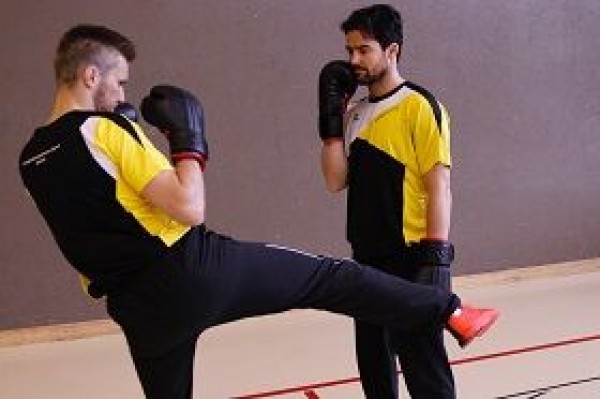


► Uppercut (crosswise, i.e. left fist to the opponent's left hand)
The passive participant can occasionally execute punching movements to which the active participant must react appropriately (e.g. evasive movements). This ensures that the defence is not neglected.
Variant:
Integrate footwork as well:
- Place the hand on the side of the body - back of the hand facing outwards (vary the height)
► Kick sideways onto the back of the hand - Cross the arms in front of the body - palms facing downwards
► Knee kick between the hands - Place both hands on the stomach - back of the hand facing the opponent
► Push off (leg pushed out forwards)
Participant:
1 pair of boxing gloves
Stroke combinations
Light-Contact
Partner work
Three marker cones are distributed in front of a punching bag (left-centre-right). The active participant moves from position to position (back and forth) without crossing their legs. He stops at each position to execute any combination of 2-5 punches. The partner holds the punching bag. The roles are swapped on the next round.
1 punching bag
3 marking hats
Participant:
1 pair of boxing gloves
Stroke combinations
Light-Contact
Partner work
Both participants have a punching bag at their disposal to perform any combination of 2-5 punches. A distinction is made between soft (light-contact) and hard combinations.
2 punching bags (one punching bag per participant)
Participant:
1 pair of boxing gloves